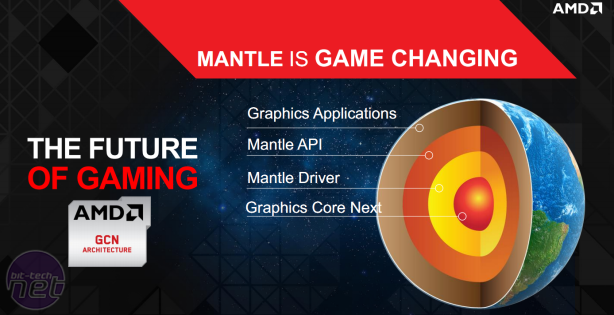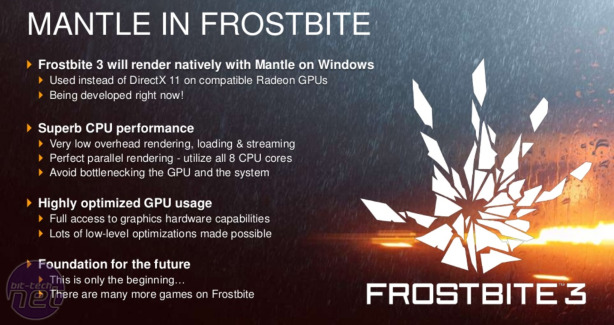
Test Setup
Instead of testing every CPU and GPU combination under the sun, we've focussed our initial Mantle testing on hardware combinations that we think will be most relevant and interesting to our readers. For discrete GPUs, we're testing using our usual graphics test rig with three cards that cover important price points in AMD's product stack: the R9 290X, R9 280X and R7 260X. As the R9 280X is based on older GCN 1.0 hardware, this will also enable us to compare the impact Mantle has on this versus the newer GCN 1.1 architecture of the remaining cards.As our GPU test rig uses an Intel Core i5-3570K running at 4.2GHz, which is a pretty nippy CPU by today's standards, we wanted to simulate a more CPU limited environment. As such, we re-run each of the discrete GPU tests while limiting the CPU to 2.8GHz and only enabling three of its four available cores and threads.

We'll also be running tests on the latest APUs from AMD, the A10-7850K and A10-7700K. This allows us to see what performance improvements can be squeezed from integrated graphics solutions. There are certainly more tests that could be carried out than what we've outlined above, but it should still give us enough of a data range to draw insight from at this early stage of Mantle's life.
We've stuck to our standard single player benchmark for testing. Multiplayer is too varied and non-repeatable to produce consistent and reliable results, which are important when trying to tease out performance differences that are potentially only marginal. This is unfortunate as it's in multiplayer scenarios that the game is likely to be more CPU-limited and more relevant to the majority of users, but having repeatable and accurate results takes precedence.

One final word on how we recorded the data: for the standard DirectX results we've used a 60-second FRAPS recording as usual, and repeated the benchmark at least three times in each case to ensure accuracy. However, FRAPS doesn't recognise the Mantle API, so for those results we've had to record the data using a new in-game console command. To begin a recording, simply bring up the console and enter “PerfOverlay.FrameFileLogEnable 1”, then do the same thing replacing the “1” with a “0” when you wish to stop. At this point, a .csv file will be generated containing the time taken in ms to generate every single frame within the recording period. Using this data, we can then calculate the average framerate for the run, and it's this that we'll be basing our comparisons on for now. With DirectX, both FRAPS and the in-game recording generate average framerate results that are almost identical, so comparing data from the two methods is fair game.
Discrete GPU Test System
- Intel Core i5 3570K
- Asus Maximus V Extreme motherboard
- 2 x 4GB Corsair 2,400MHz DDR3 memory
- Lepa G1600 1600W PSU
- Windows 7 Home Premium 64bit
- Samsung SSD 830 256GB SSD
Integrated GPU (Kaveri) Test System
- Gigabyte G1.Sniper A88X motherboard
- 8GB (2x 4GB) Corsair Dominator Platinum 2,133MHz DDR3 memory (CL9)
- 256GB Plextor M5 Pro SSD
- Corsair H80i CPU cooler
- PC Power & Cooling Silencer 750W PSU

MSI MPG Velox 100R Chassis Review
October 14 2021 | 15:04








Want to comment? Please log in.